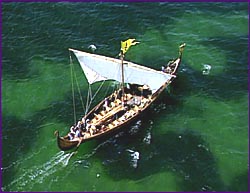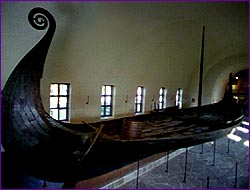
|

|
by Evan Hadingham For three turbulent centuries, the glimpse of a square sail and dragon-headed prow on the horizon struck terror into the hearts of medieval Europeans. Indeed, the Viking Age, from A.D. 800-1100, was the age of the sleek, speedy longship. Without this crucial advance in ship technology, the Vikings would never have become a dominant force in medieval warfare, politics, and trade. The drekar, or dragon-headed longships, were stealthy troop-carriers. They could cross the open oceans under sail and then switch to oars for lightning-fast hit-and-run attacks on undefended towns and monasteries. Far surpassing contemporary English or Frankish vessels in lightness and efficiency, longships carried Viking raiders from northern England to north Africa. Viking expertise in naval craftsmanship soon led to the evolution of other types of ship. Among these were the knarr, or ocean-going cargo vessel, which facilitated far-flung trade networks and the colonization of Iceland, Greenland, and America. The knarr drew on similar design principles as the longship but was higher and wider in relation to its length and had only limited numbers of oars to assist with maneuvers in narrow channels. Cargo decks were installed fore and aft. Proof in the planking The secret of the Viking ship lay in its unique construction. Using a broad ax rather than a saw, expert woodworkers would first split oak tree trunks into long, thin planks. They then fastened the boards with iron nails to a single sturdy keel and then to each other, one plank overlapping the next. The Vikings gave shape to the hull using this "clinker" technique rather than the more conventional method of first building an inner skeleton for the hull.
The longships' light, economic construction was a major factor behind their success. Modern replicas have achieved speeds of up to 14 knots. In marked contrast to modern sailboats, the ships' lack of a big, vertical keel meant that they were highly maneuverable and could easily penetrate shallow surf and river estuaries. Seafarers steered using a single side rudder on the right, the 'starboard' or "steering board" side. (The term 'starboard' is thought to have originated in the Viking era.) They could also reef the square sails in strong winds and adjust them to permit rapid tacking. Preserved to the present Famous discoveries of Viking ships at Gokstad and Oseberg, Norway, in 1880 and 1906, respectively, established the classic image of the dragon-headed warship. Longships from both sites were preserved almost intact, with lavish carved decoration, in the waterlogged clay of royal burial mounds. Built around A.D. 890, three quarters of a century after the Oseberg ship, the Gokstad vessel shows great improvements in design, particularly in the sturdiness of the mast supports. Not surprisingly, this era, during which the Norse perfected longship design, coincides with the eruption of seaborne Viking raids on the monasteries and towns of Europe.
The major revelation at Skuldelev was the variety of the vessels, which ranged from a stocky cargo ship with a capacity of 24 tons to two sleek longships. The larger of the longships, measuring 95 feet in length, had made at least one successful crossing of the North Sea, for tree-ring analysis of its oak timbers revealed that they had been cut down around A.D. 1060-70 near Dublin, suggesting the presence of a major shipyard at this key Viking stronghold in Ireland. Even more remarkable discoveries were to follow in 1996, when contractors began expanding Roskilde's waterfront museum, originally built to house the finds from Skuldelev. As astonishing as it sounds, no fewer than nine wrecked medieval ships eventually turned up in different spots around the building site, including one under the museum's car park. Continue: The most striking discovery... Explore a Viking Village | Who Were the Vikings? Secrets of Norse Ships | The Viking Diaspora Write Your Name in Runes | Build a Tree-Ring Timeline Resources | Transcript | Site Map | The Vikings Home Editor's Picks | Previous Sites | Join Us/E-mail | TV/Web Schedule About NOVA | Teachers | Site Map | Shop | Jobs | Search | To print PBS Online | NOVA Online | WGBH © | Updated November 2000 |


